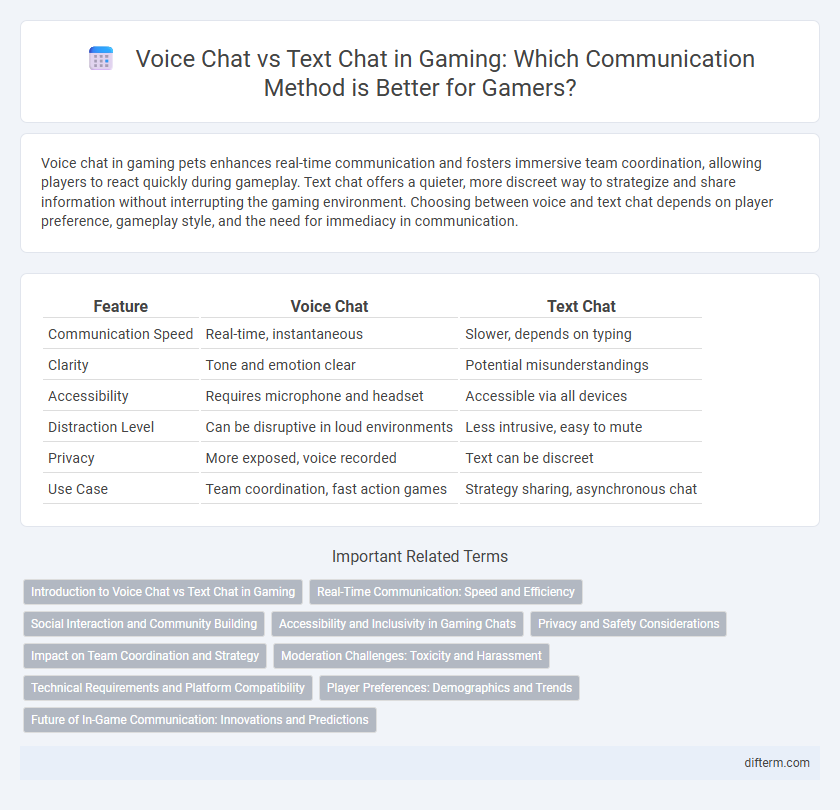Voice chat in gaming pets enhances real-time communication and fosters immersive team coordination, allowing players to react quickly during gameplay. Text chat offers a quieter, more discreet way to strategize and share information without interrupting the gaming environment. Choosing between voice and text chat depends on player preference, gameplay style, and the need for immediacy in communication.
Table of Comparison
| Feature | Voice Chat | Text Chat |
|---|---|---|
| Communication Speed | Real-time, instantaneous | Slower, depends on typing |
| Clarity | Tone and emotion clear | Potential misunderstandings |
| Accessibility | Requires microphone and headset | Accessible via all devices |
| Distraction Level | Can be disruptive in loud environments | Less intrusive, easy to mute |
| Privacy | More exposed, voice recorded | Text can be discreet |
| Use Case | Team coordination, fast action games | Strategy sharing, asynchronous chat |
Introduction to Voice Chat vs Text Chat in Gaming
Voice chat enhances real-time communication and coordination among gamers by allowing instant verbal interaction, which is crucial in fast-paced multiplayer games. Text chat provides a discrete and non-intrusive method to exchange messages, beneficial for players who prefer typing or require communication without sound. Both voice and text chat serve vital roles in gaming, offering diverse communication options to accommodate different gameplay styles and player preferences.
Real-Time Communication: Speed and Efficiency
Voice chat offers superior real-time communication speed compared to text chat, enabling players to coordinate instantly during fast-paced gaming scenarios. The immediate audio transmission reduces delays and enhances teamwork efficiency, especially in multiplayer and competitive games. Text chat, while useful for detailed instructions, often lags behind in delivering rapid responses necessary for high-intensity gaming environments.
Social Interaction and Community Building
Voice chat enhances social interaction in gaming by enabling real-time communication, fostering stronger bonds and teamwork among players. Text chat offers asynchronous communication that supports inclusive community building, allowing players to engage thoughtfully and reference past conversations. Combining both voice and text chat creates a versatile social environment that caters to diverse player preferences and enhances overall community cohesion.
Accessibility and Inclusivity in Gaming Chats
Voice chat enhances accessibility for gamers with visual impairments by allowing seamless communication without relying on reading text. Text chat provides an inclusive option for players with hearing difficulties or those in noise-sensitive environments, ensuring everyone can participate. Combining voice and text chat options creates a gaming environment that supports diverse communication needs and fosters community engagement.
Privacy and Safety Considerations
Voice chat in gaming presents unique privacy risks due to the real-time transmission of audio, making it easier for malicious actors to capture personal information or harass players. Text chat offers greater control over message content and moderation, enabling better filtering of harmful language and reducing exposure to voice-based threats. Implementing robust reporting systems and encryption protocols enhances safety in both communication methods, but text chat generally allows for more effective monitoring and user protection.
Impact on Team Coordination and Strategy
Voice chat enhances real-time communication, allowing players to quickly relay information and adjust strategies during gameplay, which significantly boosts team coordination. Text chat, while useful for detailed planning and sharing complex information, can slow down communication speed and disrupt the flow of action. Effective team strategy often depends on the immediate feedback and seamless interaction enabled by voice communication in fast-paced gaming environments.
Moderation Challenges: Toxicity and Harassment
Voice chat in gaming presents significant moderation challenges due to the immediacy and anonymity that often escalate toxicity and harassment. Unlike text chat, voice communication is harder to monitor and filter, making it difficult to detect abusive language or disruptive behavior in real time. Game developers increasingly rely on AI-driven voice recognition tools and community reporting systems to address these issues and maintain a safer gaming environment.
Technical Requirements and Platform Compatibility
Voice chat requires low-latency audio processing and stable broadband connections to ensure real-time communication, often leveraging VoIP protocols like WebRTC for minimal lag. Text chat demands less bandwidth and can operate effectively on slower networks, relying on simple message delivery systems compatible across virtually all gaming platforms. Platform compatibility favors text chat for cross-play environments, while voice chat necessitates integrated audio hardware and software support specific to consoles, PCs, or mobile devices.
Player Preferences: Demographics and Trends
Younger gamers, especially those aged 18-24, show a strong preference for voice chat due to immediacy and team coordination benefits, while older players often favor text chat for its control and privacy. Studies indicate that competitive gaming genres like shooters predominantly utilize voice communication, whereas casual and strategy games lean towards text. Gender also influences preferences, with male players more inclined toward voice chat and female players showing higher engagement in text-based interactions.
Future of In-Game Communication: Innovations and Predictions
Voice chat will dominate future in-game communication by offering real-time, immersive interaction enhanced with AI-driven voice modulation and spatial audio for more realistic team coordination. Text chat will evolve through advanced natural language processing, enabling instant translation and contextual suggestions that improve clarity and reduce toxicity. Hybrid communication systems integrating voice and text, supported by machine learning for adaptive user preferences, will redefine player engagement and inclusivity in gaming environments.
voice chat vs text chat Infographic

 difterm.com
difterm.com